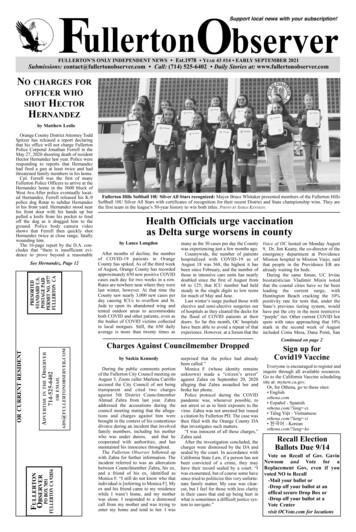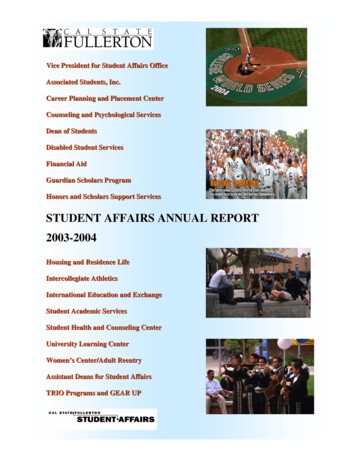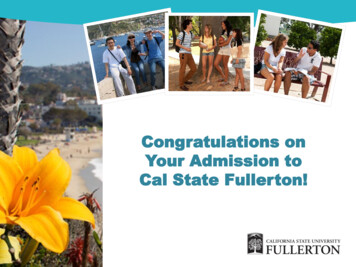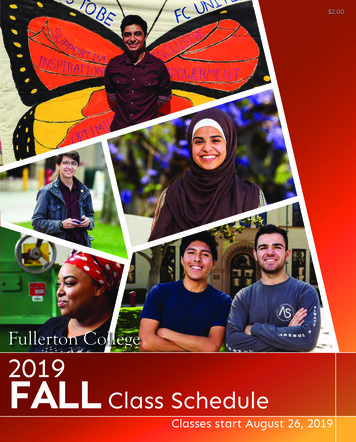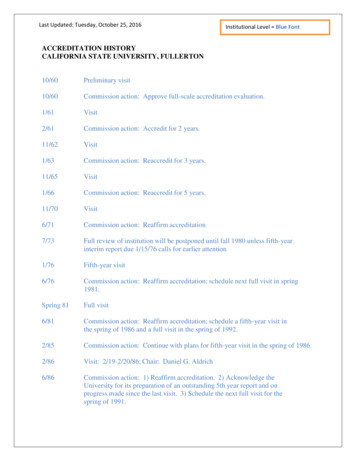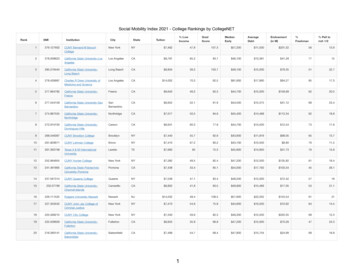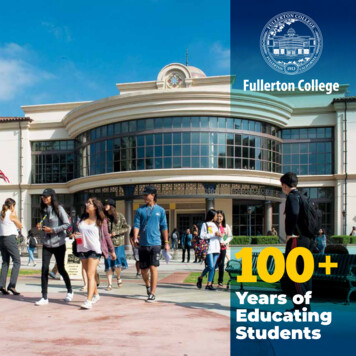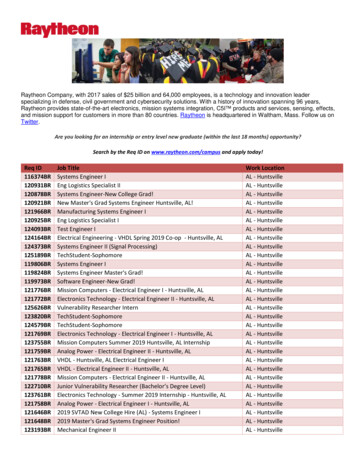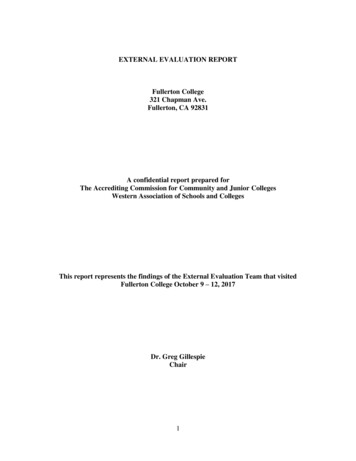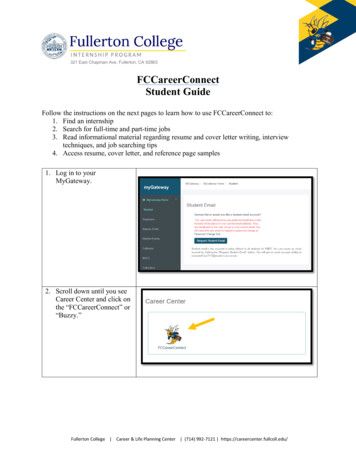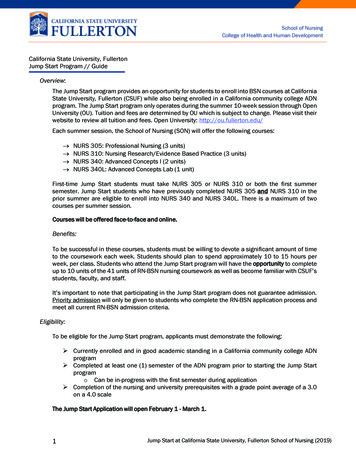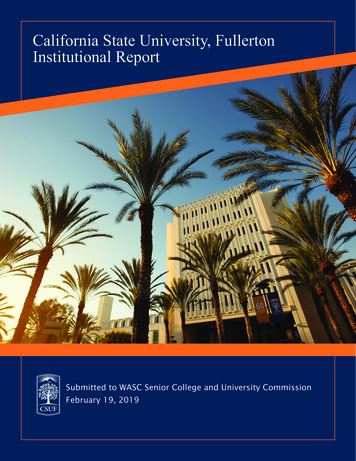
Transcription
California State University, FullertonInstitutional ReportSubmitted to WASC Senior College and University CommissionFebruary 19, 2019
CONTACTPamella H. Oliver, Ph.D.Provost and Vice President for Academic Affairs; CSUF ALOProfessor Child and Adolescent Studies2600 Nutwood Ave., Ste. 1060, Fullerton, CA 92831P: 657-278-2896alo@fullerton.edu
Table of ContentsCOMPONENT 1: Introduction to the Institutional Report . 4History and Overview . 4Mission and Strategic Plan . 5Leadership . 8Response to Previous WSCUC Reviews. 9Preparation for the WSCUC 2019 Review . 10COMPONENT 2: Compliance with Standards . 12Review under the WSCUC Standards and Compliance with Federal Requirements Worksheet . 12Inventory of Educational Effectiveness Indicators (IEEI) . 12Areas of Strength . 13Areas of Improvement . 14Next Steps . 14Conclusion . 15COMPONENT 3: Degree Programs . 17Meaning of the Degree . 17Student Learning Outcomes and Standards of Performance . 19Curriculum and Course Review . 20Faculty Accomplishments . 21Graduate Programs . 22Online Programs. 22Course Offerings at the Irvine Center . 23Conclusion . 23COMPONENT 4: Educational Quality . 24Evidence of Program Level Assessment of Student Learning . 24University Level Assessment . 26General Education Assessment. 28Efforts to Improve Teaching and Learning through Assessment . 29Conclusion . 32California State University, FullertonTitans Reach Higher1
COMPONENT 5: Student Success . 33Academic Advising . 33Student Success Initiatives and Supports . 36Evidence of Student Success . 39Conclusion . 44COMPONENT 6: Quality Assurance and Improvement . 45Office of Assessment and Institutional Effectiveness . 45Network of Campus-Wide Assessment. 45Co-Curricular Assessment . 46Assessing the Assessment Process. 47Culture of Assessment . 48Commitment to Continuous Improvement . 49Program Performance Review (PPR). 50Conclusion . 51COMPONENT 7: Sustainability . 52Financial Condition and Stability. 52Aligning Funding Priorities and Decision-Making . 54Enrollment Management . 54Resources and CSUF’s Commitment to Educational Effectiveness . 55Facilities, Environment, and Deferred Maintenance . 56IT Resources . 57Library . 58Conclusion . 59COMPONENT 8: Institution-specific Themes . CSUF did not pursue institution-specific themesCOMPONENT 9: Conclusion . 61Acronyms . 64California State University, FullertonTitans Reach Higher2
Links to Appendices . (Links not available on web-hosted report)1.1WSCUC reviewer guest login2.1.0WSCUC self-inventory2.1.1Role of the president2.1.2CFO position description2.1.3Sample syllabi of online/hybrid courses2.1.4Sample syllabi of non-typical courses2.1.5Student complaint policy2.2WSCUC inventory of educational effectiveness indicators (IEEI)2.3Provost’s online strategy task force summary report3.1Face-to-face course syllabi examples3.2Curriculog example screenshot4.1Critical thinking rubric4.2First year experience student reflection papers5.1TitanNet one-sheet summary5.2Student success dashboard screenshot6.1Assessment feedback examples7.1SEM models and meeting agenda7.2Financial statements7.3Course enrollment dashboard (draft) screenshot7.4California State University deferred maintenance report7.5Space utilization report9.1Graduation check process timeline9.2GI 2025 bottleneck review summary9.3Roadmaps examplesCalifornia State University, FullertonTitans Reach Higher3
COMPONENT 1Introduction to the Institutional Report:Institutional Context; Response to Previous Commission Actions(CFRs 1.1, 1.4, 1.5, 1.8, 3.2, 3.6, 3.7, 3.8, 3.9, 3.10, 4.6)History and Overview(CFRs 1.1, 1.4, 1.5)California State University, Fullerton (CSUF) was established on July 5, 1957, as the 12thcampus of the now 23-campus California State University (CSU) system. At the time of itsfounding, CSUF was situated in a region with a fairly homogeneous population, predominantlyof European descent. Over the succeeding 60 years, and particularly since the 1980s, themakeup of Orange County has become more ethnically diverse with increases in Hispanic,Asian, and other populations. Dedicated to serving the constituents of its region, CSUF hasresponded agilely to this shifting Orange County landscape. The percentage of Hispanic studentsat CSUF, for instance, rose from 26% in 1993 to 41.5% in 2018, reflecting the similardemographic change in Orange County. As with its student population, CSUF’s faculty and staffpopulations grew increasingly diverse over the years. Embracing this rich diversity, CSUFremains mindful of the different needs of its many constituents and pursues multi-facetedstrategies to support the educational, professional, and personal growth of its students, faculty,and staff.From its inception, the University sought to serve students by pairing applied and liberal artsfields of study. In the 1959-60 University catalog, CSUF President W.B. Langsdorf advocatedthat “a college education must provide students with a broad liberal background and at the sametime can and should furnish the practical base for success in a chosen occupation or profession.”This philosophy has remained central to CSUF’s values. The 2016 University Academic MasterPlan (AMP) reaffirms and extends the original philosophy articulating CSUF’s commitment to:“Offer[ing] a comprehensive, dynamic, outcome-driven curriculum that prepares students forsuccess in academic, personal, and professional lives and for engagement with local and globalcommunities.” As noted in the 2018-19 University catalog, a CSUF education seeks to equipstudents with knowledge and skills that prepare them to be “effective and ethical leaders, andproductive members in their local communities and the global society” (see “Meaning ofDegree” section of the catalog). (CFR 1.1, 1.5)A comprehensive University, CSUF offers 110 degree programs – 56 undergraduate and 54graduate – including doctorates in education and in nursing practice. Providing broad access toeducational opportunities, CSUF has awarded more than 265,000 degrees since its establishment.The most recent information on degrees awarded (2017-18) shows that, out of the 10,974 degreerecipients, 39% were from underrepresented groups, and 54% were the first in their family toearn college degrees.Diversity and inclusivity are key to the University’s story. CSUF is a Hispanic-ServingInstitution and an Asian American and Native American Pacific Islander-Serving eligibleCalifornia State University, FullertonTitans Reach Higher4
Institution, with over 40% of students from underrepresented groups. The campus is fifth in thenation and third in the state in awarding bachelor’s degrees to Hispanics, and fourth in the nationfor bachelor’s degrees awarded to underrepresented students (Diverse: Issues in HigherEducation, August 2018). CSUF’s award of bachelor’s degrees to women was the highest in theCSU, and second in California (IPEDS 2016-17). US News and World Reports has rankedCSUF among top National Universities since 2016, and in 2017 listed CSUF as one of the “MostInnovative Schools.” Locally, the Orange County Black Chamber of Commerce honored CSUFfor 60 years of helping students succeed, commending the University for being “a continuedstrong leading force for education, leadership, research and diversity.” (CFR 1.4)Because of CSUF’s focus on increasing faculty diversity, 52% of the 290 new faculty hiredbetween 2012 and 2018 were faculty of color. As a result, CSUF has a more diversified profileof tenured and tenure-track faculty as of fall 2018, with an 11% increase in female faculty (43%in fall 2012 vs. 48% in fall 2018) and a 19% increase in faculty of color (31% in fall 2012 vs.37% in fall 2018). Similarly, on the staff side, in academic year 2017-18 alone, 56% of the staffhired into permanent positions were of color. (CFR 1.4)The leadership of CSUF has understood from the beginning that continued growth was essentialto realizing the University’s commitment to access and opportunity. As documented in the1959-60 catalog, “The president was originally instructed to plan for 15,000 students bythe early 1970s. Later the instruction was changed to plan for 35,000 students [by] 1980.”True to that vision, CSUF has expanded its educational reach from a local college of 459students in 1959 into a comprehensive, regional university with a global outlook that enrollsapproximately 40,000 students today. The University provides instruction and support for thesestudents on compact acreage in Fullerton with 207 lecture-type classrooms and student housingfor 1,980 residents. The recent 27,000-square foot expansion of the Titan Student Unionexemplifies the campus’s commitment to meeting the needs of the growing student body. CSUFalso supports instruction and University activities at locations other than Fullerton. For example: CSUF’s Irvine Center provides instructional space, as well as community outreach shaped byregionally specific academic and professional development opportunities; The Grand Central Art Center in Santa Ana, led by the College of the Arts, promotes artist,student, and community collaborations in contemporary art and visual culture; The Tucker Wildlife Sanctuary in Modjeska Canyon serves as a field research center forCSUF students and promotes science and environmental education for the local community;and The Desert Studies Center, located in the Mojave National Preserve, is a CSU consortium ledby CSUF offering on-location research and educational opportunities.Mission and Strategic PlanT(CFRs 1.1, 1.5, 3.7, 4.6)rue to its founding vision, CSUF continues to combine the best qualities of teaching andresearch universities to provide its diverse group of students an affordable, quality education.California State University, FullertonTitans Reach Higher5
Strategic planning is instrumental in achieving the University’s mission, which has recently beenupdated to: (CFR 1.1)California State University, Fullerton enriches the lives of students andinspires them to thrive in a global environment. We cultivate lifelong habitsof scholarly inquiry, critical and creative thinking, dynamic inclusivity, andsocial responsibility. Rooted in the strength of our diversity and immersiveexperiences, we embolden Titans to become intellectual, community, andeconomic leaders who shape the future.Drawing on planning efforts and collaborations across campus through workgroups, town halls,electronic feedback, and presentations to numerous constituency groups (e.g., Council of Deans,Academic Senate, and Philanthropic Board), CSUF presented its first University Strategic Plan2013-18 (USP2013) on April 12, 2013. The plan outlined four goals and fifteen objectivesaddressing curricular and co-curricular environment, student success, faculty and staff diversity,and University finances. Following suit, all divisions, colleges, and various units undertook theirown strategic planning (see examples from College of Humanities and Social Sciences, StudentAffairs, and Information Technology), aligning their goals with USP2013. CSUF’s first AMPcomplements USP2013. Signed by President Mildred García in December 2016, the AMPidentifies seven long-term goals, which address curriculum quality, student success, studentaccess, faculty and staff support, commitment to diversity, infrastructure, and sustainability, andthat serve as the foundation for the University Strategic Plan 2018-23 (USP2018), as well as forfuture University strategic plans. (CFRs 1.1, 1.5, 3.7, 4.6)The campus has made significant progress toward meeting USP2013’s goals and objectives.Highlights include: For Goal 1 (curricular and co-curricular environment), CSUF implemented a campus-wideprocess of assessing student learning, expanded and improved student advising, andsupported participation by more than 15,000 students in a wide variety of high impactpractices including study abroad; For Goal 2 (retention and graduation), between 2012-18, CSUF’s efforts to meet the needs ofstudents resulted in: 1) a reduction in the underrepresented student equity gap (defined as thegraduation rate gap between underrepresented students in comparison to their peers) in firsttime freshmen (FTF) 6-year graduation rates from 11.5% to 7.7%; and 2) elimination of the4-year graduation rate equity gap for transfer students (from 5.7% to -1.8%). At the sametime, CSUF achieved an 11.5 percentage point gain (82.1% increase) in 4-year graduationrates for FTF (from 14.0% to 25.5%), and a 16.7 percentage point gain (32.7% increase) in 6year graduation rates for FTF (from 51.1% to 67.8%). For upper-division transfer students(UDT), the 2-year graduation rate increased by 7.4 percentage points (25.6% increase) from28.9% to 36.3%, and the 4-year graduation rate had an 11.8% percentage point growth(17.4% increase) from 67.7% to 79.5%; Efforts for Goal 3 (high quality and diverse faculty and staff) led to an increase in faculty andstaff diversity. As mentioned earlier, 52% of the 290 new faculty hired between 2012 andCalifornia State University, FullertonTitans Reach Higher6
2018 were faculty of color, and in academic year 2017-18 alone, 56% of the staff hired intopermanent positions were of color; and Lastly, for Goal 4 (revenue), philanthropic activity has been steadily increasing, with morethan 21M raised in 2015-16, 2016-17, and 2017-18 respectively. The Universityendowment has nearly doubled from 34.3M at the close of 2011-12 to 65M at the end of2017-18.Building upon USP2013 accomplishments, at the fall 2017 convocation, President García kickedoff the development process of USP2018. Early in fall 2017, USP2018 planning committeemembers and co-chairs were identified, and by October 2017, the committee began gatheringinitial campus feedback to identify opportunities for growth, emerging initiatives and priorities,and aspirations that could be incorporated in USP2018. The USP2018 steering committeeidentified a timeline for completing the plan that allowed sufficient opportunities for campusengagement and reflection. In an all-campus exercise in November 2017, faculty, staff, students,and administrators identified salient issues that served as a foundation for the preliminary draft ofUSP2018. The work on USP2018 continued through transitions in leadership followingPresident García’s departure in December 2017. After President Framroze Virjee’s arrival atCSUF in January 2018, he led a town hall on USP2018 to review the preliminary draft. In the 10months that followed, multiple rounds of review and revision took place with variousconstituency groups, and the final USP2018 was released to the campus in November 2018. (CFRs3.7, 4.6)USP2018 serves as a continuation and expansion of USP2013 by restating core values of theUniversity: student success; scholarly and creative activities; diversity, equity, and inclusion;civic engagement; collegial governance; integrity; and service to the region. USP2018 focusedthe work of the University for the next five years around four goals, each of which will beimplemented with specific objectives and strategies:Goal 1: Provide a transformative educational experience and environment for allstudents;Goal 2: Strengthen opportunities for student completion and graduation;Goal 3: Recruit and retain high-quality and diverse faculty and staff; andGoal 4: Expand and strengthen financial and physical capacity.As stated in USP2018, these goals will “focus and galvanize stakeholders in enhancing Cal StateFullerton’s role as a first-choice institution and a university of significance in our state andnation.”The CSU 2025 Graduation Initiative (GI2025) goals provide an additional framework forCSUF’s mission and strategic plan. With targets determined by the CSU, CSUF is expected toincrease the 4-year graduation rate for FTF from 22% to 44%, and the 6-year graduation ratefrom 62% to 75% between 2016 and 2025. Similarly, CSUF is expected to increase UDTstudents’ 2-year graduation rate from 32% to 44%, and the 4-year graduation rate from 75% to85%. GI2025 also seeks to eliminate equity gaps for underrepresented students and Pell-grantrecipients. As described in detail in Component 5, implementing innovative strategies to reachthese targets has yielded encouraging results. As of 2018, CSUF’s FTF 4-year graduation rate isCalifornia State University, FullertonTitans Reach Higher7
25.5% and the 6-year graduation rate is 67.8%; CSUF’s UDT 2-year graduation rate is 36.3%and the 4-year graduation rate is 79.5%. The equity gap for underrepresented students is 7.7%and for Pell-grant recipients is 5.3%. Many of these student success indicators are the mostpositive in CSUF history.Leadership(CFRs 1.4, 3.2, 3.6, 3.7, 3.8, 3.9, 3.10, 4.6)Campus governance is the responsibility of the president per order of the CaliforniaLegislature, CSU Board of Trustees, and CSU Chancellor policies. CSUF's seventhpresident, Mildred García, joined the campus in June 2012 after the 2012 WSCUC review. Sherecognized that policies and practices, including hiring initiatives, should address regionalchanges, specifically in ethnic diversity, and the institution responded. In 2013, CSUF createdthe Division of Human Resources, Diversity, and Inclusion (HRDI), which provides training forall search committees and ensures that hiring practices fully consider issues of diversity. TheUniversity also appointed an assistant vice president overseeing the Office of Diversity,Inclusion, and Equity Programs (DIEP); hired a director to oversee the Male Success Initiative;and appointed a director overseeing the campus cultural centers. In addition, President Garcíacreated the President’s Commission on Equity and Inclusion, comprising representatives fromfaculty, staff, administration, students, and campus affinity groups, to focus on campus climateand barriers to student success. CSUF’s effort in this regard was recognized with the 2014“Inclusion Cultivates Excellence” award from the College and University ProfessionalAssociation for Human Resources and the Insight Into Diversity’s Higher Education Excellence inDiversity Award in 2018. This effort continued with the establishment of the Faculty Diversityand Inclusion Fellows program in June 2018 by HRDI to further support sustainable diversitypractices in the colleges. Faculty fellows work closely with DIEP to identify specific collegelevel goals and expectations that are important for faculty recruitment, reappointment,advancement, and retention. The fellows also assist with pipeline development to enhancerecruitment efforts to address identified underrepresentation among faculty. The campuscontinues to expand advertising to enrich the applicant pool and to revamp job announcements toattract diverse, highly-qualified applicants. In addition, online professional developmentmodules are provided to all search committees to enhance their expertise in recruiting diversecandidates. (CFRs 1.4, 3.2, 3.6)President García’s arrival was accompanied by other changes in leadership as well, with newUniversity vice presidents (VPs), new college deans, and the formation of the President’sAdvisory Board (PAB). This board comprises the VPs; deans; University counsel; AcademicSenate chair; Planning, Resource, and Budget Committee chair; and Associated Students Inc.(ASI) president. Shifts in CSUF's leadership structure, including the aforementioned formationof HRDI in 2013, created spaces for additional administrative leaders. President García departedin December 2017 to become president of the American Association of State Colleges andUniversities. Framroze Virjee, CSU executive vice chancellor, general counsel, and secretary tothe CSU Board of Trustees, was appointed president of CSUF on January 1, 2018, for a termthrough June 2019. President Virjee has provided visionary leadership despite the short time hehas been on campus, including implementing the University’s first-ever comprehensivefundraising campaign; initiating a faculty fellows program to examine practices related to facultyrecruitment, retention, and promotion; renovating the first floor of the Library to create newCalifornia State University, FullertonTitans Reach Higher8
space for cultural groups and resource centers; and opening an official faculty and staff lounge toenrich the campus community. The CSU initiated a national search for the next permanentpresident of CSUF in fall 2018, and an announcement of that appointment is expected in spring2019. Despite these changes, the overall leadership structure has remained relatively stable andprovided continued support to the CSUF mission and strategic direction. (CFRs 3.6, 3.7, 3.8)CSUF’s stability rests in part on a strong tradition of shared governance. The Academic Senate,which in 1986 replaced the Faculty Council formed in 1972, serves as the official legislativebody of the University and as a crucial forum for debate. The Senate oversees the creation andimplementation of University policy statements, policies that guide all academic and many otheraspects of University operation. Unlike similar governing bodies at other institutions, CSUF’sAcademic Senate includes representation from all constituencies: faculty, staff, andadministrators, as well as students represented by two members of the CSUF ASI board. Thechair of the Senate is a member of the PAB. In addition to the Academic Senate, variousUniversity, college, and department committees – which include faculty, staff, administrators,and students – initiate, review, and recommend University programs and procedures, with thefinal approving authority vested in the University president. This commitment contributed to theestablishment of the aforementioned strategic plans, which helped focus CSUF on a shared path.Voices from outside the campus community participate through the Philanthropic Foundationboard of governors. CSU system-wide evaluative procedures for campus presidents and formanagement plan personnel ensure accountability, as well as compliance with the mandates ofCalifornia Education Code (Title 5 of the California Code of Regulations). (CFRs 3.6, 3.9, 3.10,4.6)Response to Previous WSCUC Reviews(CFR 1.8)The WSCUC 2012 reaffirmation review highlighted four issues: 1) engaging with anintegrated strategic plan; 2) assessing and improving student learning; 3) advancing studentadvising and improving graduation rates; and 4) addressing ongoing state funding challenges.CSUF has made great strides on all issues through the following efforts:Issue 1 (Strategic Planning): developed and completed USP2013 and aligned campuspriorities with its goals; and updated USP2013 to USP2018, which is currently beingimplemented;Issue 2 (Assessment): reinvigorated a central office to lead assessment efforts on campus;developed institution-wide undergraduate, graduate, and GE learning goals; establishedand implemented a uniform six-step assessment process across academic programs andall divisions; and implemented an online platform for documenting assessment activities(see Components 3, 4 and 6);Issue 3 (Advising): emphasized the importance of advising in USP2013 and reconceptualized advising through innovations, such as the Student Success Teams,described in depth in Component 5; andCalifornia State University, FullertonTitans Reach Higher9
Issue 4 (Funding): implemented diverse funding strategies, passed the Student SuccessInitiative fee, and secured alternative funding streams through philanthropic venues (seeComponent 7).Initial progress toward these efforts was described in the 2015 WSCUC Interim Report, to whichthe Interim Report Committee responded positively. The Committee commended CSUF for its“considerable improvements,” noting the “establishment of a robust infrastructure for ongoingassessment, including revitalization of the central assessment office and creation of facultyassessment liaisons; a nicely developed strategic plan that is aligned with the budget; a wellfunded and comprehensive advising effort that is making a difference in student success; animproved timeline for delivery of the budget; and a renewed commitment to diversity.”The WSCUC 2015 Interim Review also requested an update of the Irvine Center. Since thereview, the Irvine Center has been re-en
California State University, Fullerton Titans Reach Higher 6 Strategic planning is instrumental in achieving the University's mission, which has recently been updated to: (CFR 1.1) California State University, Fullerton enriches the lives of students and inspires them to thrive in a global environment. We cultivate lifelong habits
